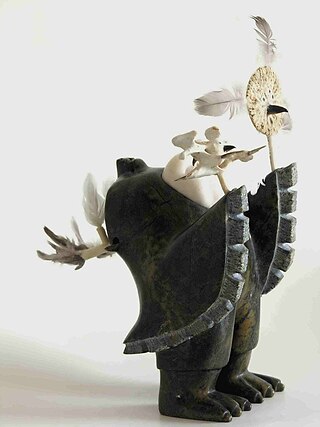The Sun and the Moon is an unipkaaqtuat, a story in Inuit folklore. The traditional explanation for the movement of the Sun and Moon through the sky is that a brother and sister are constantly chasing each other across the sky. The story also explains the moon's dappled gray appearance as soot smeared on his face.

Jessie Oonark, was a prolific and influential Inuk artist of the Utkuhiksalingmiut Utkuhiksalingmiut whose wall hangings, prints and drawings are in major collections including the National Gallery of Canada.
Irene Avaalaaqiaq Tiktaalaaq is one of Canada's most renowned Inuit artists. Her work is rooted in her lived experience, often dealing with themes of being an orphan and Inuit stories her grandmother told her. Avaalaaqiaq Tiktaalaaq is noted for her drawings, prints, and wall hangings.

Inuit art, also known as Eskimo art, refers to artwork produced by Inuit, that is, the people of the Arctic previously known as Eskimos, a term that is now often considered offensive. Historically, their preferred medium was walrus ivory, but since the establishment of southern markets for Inuit art in 1945, prints and figurative works carved in relatively soft stone such as soapstone, serpentinite, or argillite have also become popular.

Walter Joseph Phillips was an English-born Canadian painter and printmaker. He is credited with popularizing the colour woodcut in the style of the Japanese, in Canada.
Agnes Nanogak Goose was an Inuk artist from Holman (Ulukhaktok), Northwest Territories, Canada.

Janet Kigusiuq was an Inuk artist.

Shuvinai Ashoona is an Inuk artist who works primarily in drawing. She is known for her detailed pen and pencil drawings depicting northern landscapes and contemporary Inuit life.
Lucy Qinnuayuak (1915–1982) was an Inuit graphic artist and printmaker.
Sheila Butler is an American-Canadian visual artist and retired professor, now based in Winnipeg, Manitoba. She is a founding member of Mentoring Artists for Women's Art in Winnipeg, Manitoba and the Sanavik Inuit Cooperative in Baker Lake, Nunavut. She is a fellow of the Royal Canadian Academy of Arts.
Ruth Qaulluaryuk is a Canadian Inuk textile artist, also known for her drawings.
Nancy Pukingrnak Aupaluktuq is a Canadian Inuit artist known for her sculptures, drawings, and textile art. Her work draws from Inuit mythology and features Western spatial perspective.
Eleeshushe Parr was an Inuk graphic artist and sculptor, from the Kingnait area, who produced over 1,160 drawings. Her work has been exhibited in Canada, the United States, and Sweden.
Luke Anguhadluq was an Inuit Canadian artist in Baker Lake.

Mary Kapbak Okheena is an Inuvialuit graphic artist known for her stencil prints including "Musk-ox Waiting for the Tide to Cross Water" (1986) and "Shaman Dances to Northern Lights" (1991), drawings and embroidery. She is part of the third generation of organized graphic artists in the Canadian Arctic. Okheena has five children with her husband Eddie and she currently lives in Inuvik where she practices embroidery and makes wall hangings.
Kiugak Ashoona was a Canadian Inuk artist renowned for his sculptural work and his expansive artistic portfolio. He experienced the longest career of any Cape Dorset artist, and is a member of the Order of Canada and the Royal Canadian Academy of Arts. In 1999, he was awarded the Canada Council Molson Prize for his outstanding lifetime contribution to the cultural and intellectual life of Canada.
Ruth Annaqtuusi Tulurialik is a Qaernermiut Inuk artist graphic artist and musician. Tulurialik was born near the Kazan River area in Nunavut but relocated to Qamani'tuaq, Nunavut with her adoptive parents when she was few months old.
Hannah Kigusiuq (1931-1995) was an Inuk artist known for her drawings and prints.
Jack Butler is an American-Canadian visual artist. His work is in public and private collections including the National Gallery of Canada. He is a founding member of Sanavik Inuit Cooperative, Baker Lake, Nunavut. He is a medical model builder and published researcher in human development. He taught at Carnegie Mellon University, at the Banff Centre, the University of Manitoba, and in the Department of Philosophy at the University of Western Ontario.
Ada Eyetoaq (1934-2014) was a Baker Lake (Nunavut) Inuk artist who produced traditional Inuit art. She is primarily known for her miniature soapstone sculptures.






